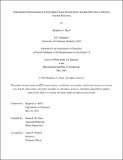Experimental Characterization of Iron-Sulfur Cluster Excited States and their Relevance to Electron Transfer Reactions
Author(s)
Skeel, Brighton A.
DownloadThesis PDF (22.76Mb)
Advisor
Suess, Daniel L.M.
Terms of use
Metadata
Show full item recordAbstract
Iron-sulfur (Fe−S) clusters, and cuboidal [Fe₄S₄] clusters in particular, are biologically ubiquitous metallocofactors involved in a diverse array of cellular processes. The electronic structures of these metallocofactors are highly multiconfigurational, and characterized by dense manifolds of low-energy excited states. The ground states for these systems have been extensively studied for several decades, and are understood to be the products of a confluence of super-exchange and spin-dependent electron delocalization interactions. On the other hand, our understanding of the excited states of these clusters—many of which are measurably populated at ambient temperature—is minimal, due largely to the fact that describing these states both experimentally and computationally is a daunting task. Here, we simplify this problem first by recognizing that imposing a particular ligand field symmetry (namely 3:1 site differentiation) on a [Fe₄S₄] cluster causes some of its excited states to become degenerate in well-defined ways. This in mind, we describe the synthesis of an array of 3:1 site-differentiated [Fe₄S₄]¹⁺ clusters, and characterize them by variable temperature (VT) solution NMR spectroscopy and magnetometry. Our global fits of these VT data using a simplified model Hamiltonian have furnished, for the first time, experimental pictures of the excited state manifolds for [Fe₄S₄]¹⁺ clusters, including both their low-energy spin states and alternate valence electron configurations (“valence isomers”). We find that the energy scale associated with both of these phenomena is commensurate with that of the thermal energy at ambient temperature, and that these alternate valence arrangements and spin configurations are thus relevant to understanding the room temperature reactivity of biological Fe−S systems. We find additionally that the primary coordination sphere has a strong influence on the topography of these excited state landscapes, in particular that the donor properties of the ligands binding an [Fe₄S₄]¹⁺ cluster determine its ground state valence electron distribution. Finally, we describe the variable temperature electron transfer self-exchange kinetics for a series of [Fe₄S₄]¹⁺/²⁺ clusters where we have experimentally mapped the excited spin state manifolds, thus taking the first steps toward connecting the excited state manifolds of these metallocofactors to their reactivities.
Date issued
2024-05Department
Massachusetts Institute of Technology. Department of ChemistryPublisher
Massachusetts Institute of Technology